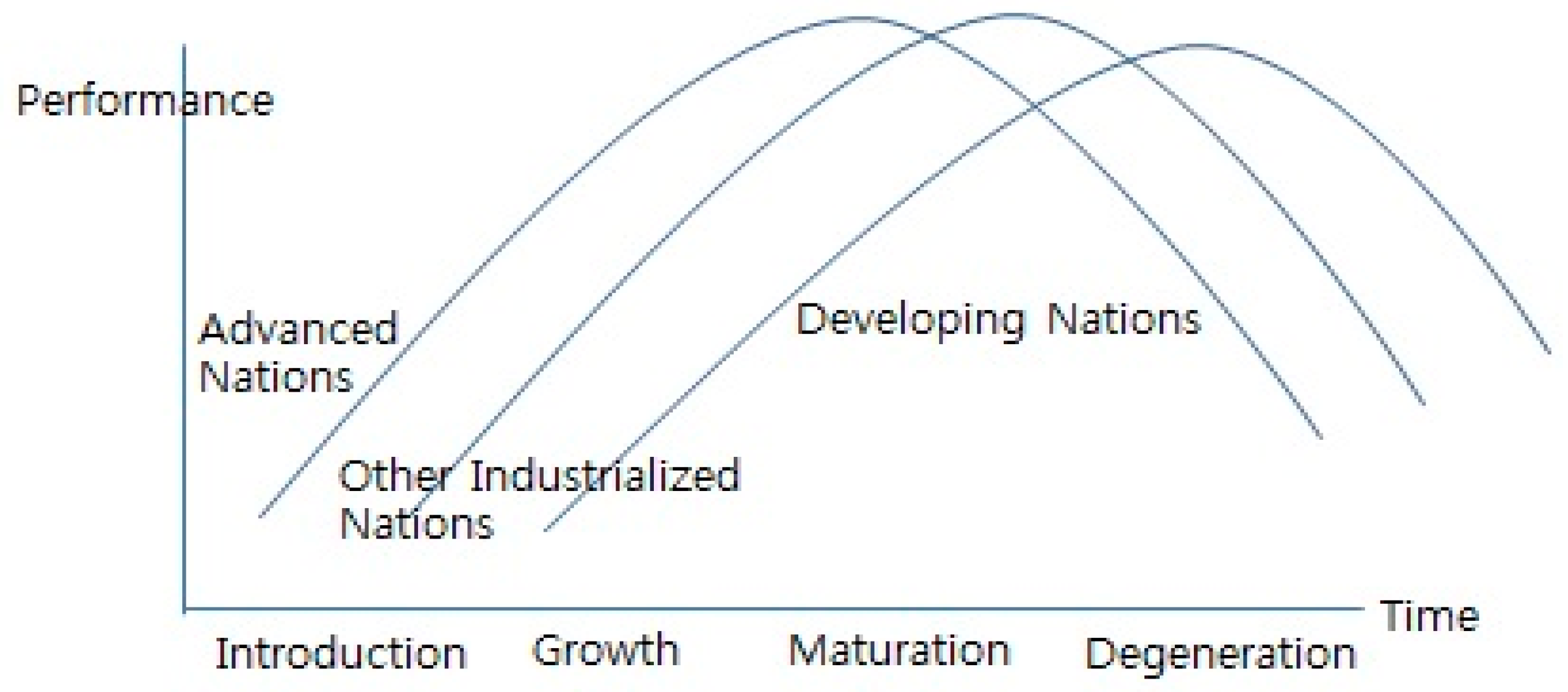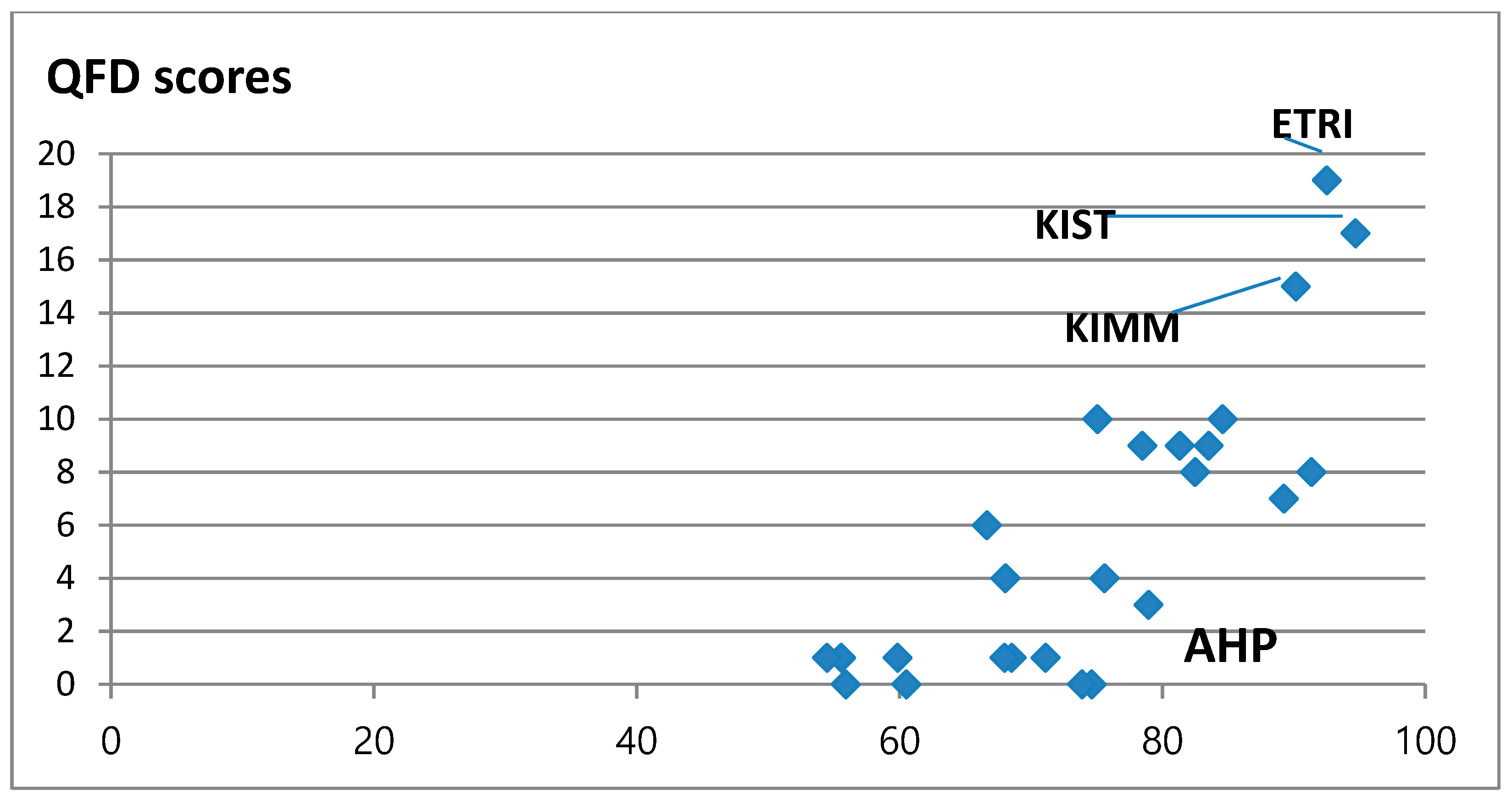1. Introduction
The 4th industrial revolution has been a hot topic in various societies for several overlapping reasons. It may be a huge wave for researchers to navigate through. In this context, research institutions are not different from major industrial sectors, in that both consider the 4th revolution a major turning point as well as a threat [
1,
2]. Today’s industries and research institutions are knowledge-intensive in nature. As a result, their potential for survival depends on scientific and technological aspects as well as their organizational dimension [
3,
4]. This implies that research institutions’ organizational and manpower strategy is one of the key aspects in understanding such institutions [
5,
6]. If the characteristic of the 4th industrial revolution can be understood as increasing connectiveness with information technology, countries that are aiming, by certain degrees, at reconfiguration of research institutions, whether they are public or private in their origin, may find similar problem definitions and solutions. This research intended to find a clue with a case study of research institutions in Korea with potential implications for other countries.
In this context, this study analyzes 25 major public research institutions located in the DaeDuk area in South Korea, based on their technological capability for organizational as well as expert evaluation. The study also proposes a matching scheme between research institutions and research topics related to the 4th industrial revolution.
3. Methodology
Data and Methodology
In order to fulfill the aim of the study, this research employed an extensive data of the 25 public research institutions in Korea during summer and fall of 2018. As for details, first, this research acquired organizational, man power-related data, and pay structure of the institutions. Second, this study acquired performance-related data that were published to have validity. Third, by processing the two data sets, this research produced a AHP survey text, which has generated new data to be analyzed in the research. Then, this study utilized three types of methods. First, a three-stage analytical hierarchy process (AHP) technique was employed to set up an in-depth analysis. Second, an organizational analysis of all the 25 public research institutions was performed by using their manpower-related data. Third, this study utilized the quality function deployment (QFD) analysis to match the potential roles of research institutions with topics under the 4th industrial revolution. Lastly, this study linked the AHP and QFD scores to derive implications for the institutions and their roles in the context of the 4th industrial revolution.
The AHP analysis (
Table 2) was carried out to assess the existing data. While it is possible to gather and analyze institution-level performance data, it is not easy to evaluate articles and patents in pure numbers. The method will urge experts to assign weight to individual institutions by looking at “all possible” performance data of the institutions. The AHP analysis was conducted with 25 experts who have been active in the research community for more than 20 years after their Ph.D. This study conducted a three-stage AHP survey to obtain relative weights of factors, which will be multiplied to organizational performance data from the 25 public institutions. AHP participants were asked to give weights at the three levels from the first stage to the third so that their averaged weighting was to be applied to the existing performance data of the 25 institutions. The first round produced a result of scientific/engineering excellence (0.669), excellence in operation/management (0.126), and efficiency in manpower and social values (0.205), which was then divided to be narrowed down to the next two stages.
QFD is a quality management technique used to match consumer demand requirements and product specifications, and later, to check the affinity between different categories. In this study, QFD was utilized to link research institutions and their potential contributions to research topics related to the 4th industrial revolution.
After completing both the AHP and QFD analyses, we plotted their results to link research institutions and their potential contribution to the 4th industrial revolution. The focus was on finding those institutions that scored high on both analyses. These organizations can serve as the mediating entity for collaborative research in the 4th industrial revolution.
5. Discussion
As shown in this paper, the 4th industrial revolution is presenting a huge challenge as well as an opportunity to different levels of organizations including research institutions [
29,
30]. This paper, noting the salience, tried to capture the changing momentum of the 25 public research institutions in South Korea. In doing so, for going beyond the already existing performance measures, this study utilized the AHP expert survey to plot organizational performance and used organizational analysis to find inflows and outflows of manpower in the institutions.
This study found several key elements that are applicable to other countries too. First, independent to the research institutions’ scientific and technological capabilities at the current period, the organizations can be transformed by just changing their manpower structure, as if a machine undergoes a major refit.
● This study suggests that there should be a non-conventional recruitment process in the future following the “I” shape organization structure. Knowing the characteristic of the 4th industrial revolution which emphasizes connectiveness with information technology, countries that are aiming, by certain degrees, at reconfiguration of research institutions, whether they are public or private in their origin, may find similar problem definitions and solutions that have been described in this research. In addition, many analytical tools seem to rearrange those institutions, which this research tried to overcome by using expert level AHP analysis.
Second, through the QFD analysis of matching, the study found that research topics related to the 4th industrial revolution can be unevenly distributed among institutions, while most of them can still contribute to the analysis. This implies that the 4th industrial revolution, due to its nature, predesignates the kind of institutions that can function as integration control towers.
● In other words, research on the 4th industrial revolution can be carried out by establishing a key institution, which will lead a group of participating research institutions. For example, in an autonomous vehicle case, it would be reasonable to find that either an IT area institution or a machine-based institution takes the leading role as a control tower, while other participating institutions follow the lead. This, in some sense, perfectly dovetails with the nature of the 4th industrial revolution, which needs connectedness between and among fields.
Third, although this study tried to present a ranking-based result from the AHP, it did not intend to foster a relative ranking system; rather, the intention was to augment the capability of interpreting the existing performance data of research institutions [
31,
32].
● As more and more research institutions and company research units are being retooled to meet the requirements of the 4th industrial revolution [
33,
34], this study tried to shed light on a new avenue to design interdisciplinary research programs [
35,
36], which can be applied in other contexts too.






